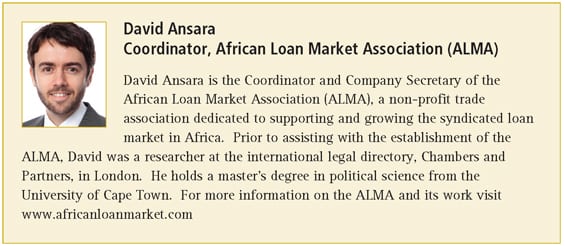
- David Ansara
- Coordinator, African Loan Market Association
by David Ansara – Coordinator, African Loan Market Association
Africa is currently at the front of the pack of emerging markets with its high levels of economic growth and improved governance and stability. As major transactions and project financing opportunities emerge, domestic corporates and multinationals operating in Africa need access to debt to finance their operations.
In order to achieve this, the African Loan Market Association (ALMA) is serving to standardise the approach to syndicated loans in South Africa and several other African jurisdictions. Sharing the same structure and objectives of the Loan Market Association (LMA) in London, the standard-form legal documentation that the ALMA provides is a key component of syndicated finance in Africa.
Until recently, much of the syndicated or club lending in Sub-Saharan Africa (particularly in the below-USD 100m market) has taken place on a bespoke basis. In the past, banks would approach law firms to draft loan agreements, who in turn would use their own precedents and internal standards, creating inconsistency in the market. The presence of a regional association in Africa modelled on the LMA has helped to reverse this trend and align industry practice with international standards.
However, there is a common misconception that these loan documents are designed only for the benefit of banks and not the organisations seeking the capital: the borrowers. This is not the case. There are myriad advantages for corporate borrowers, who benefit from greater predictability, consistency and transparency of loan documentation, as well as the efficiency that standard documents can add to a financing transaction.
1. Transparency
ALMA loan documents look and feel the same from transaction to transaction. For a borrower who is unfamiliar with a syndicated or leveraged loan agreement there is immense benefit in having an independent standard to which you can hold financiers to account. The LMA suite of documents, which the ALMA documentation follows closely, is widely recognised and accepted across global loan markets and common treasury positions have emerged over time. It is therefore difficult to conceal contentious provisions in the text, as all parties in a negotiation know what to expect. It is important to note that ALMA documents are not a one-size-fits-all or an off-the-shelf solution. Rather, the ALMA standard provides a commonly-agreed starting point for negotiations. It is then up to borrowers and lenders to negotiate their positions on key points.
2. Risk reduction
ALMA documentation is designed to shorten lead times and reduce risk by providing a common basis for discussions between a lender and the borrower. The ALMA documents create a standardised legal structure with some optional language that can be adapted to cater for the specifics of a transaction. The borrower can review block-bracketed options in the standard ALMA template and check these against the lender position. The ALMA also contains certain borrower-friendly provisions, including the notion of materiality. For example, certain representations, undertakings and events of default are qualified in respect of a ’Material Adverse Effect’ and flexible remedy periods are provided for.
3. Efficiency
The familiarity and transparency of the documentation allows the negotiating parties to focus on the key negotiation points, rather than provisions that can already be considered “market standard”. This helps to avoid excessive discussion around boilerplate terms and ultimately increases the efficiency of the negotiation process. ALMA documents assist with the streamlining of debate around representations, covenants, and events of default; previously contentious clauses that could otherwise be extremely time-consuming to draft from scratch. For example, market disruption and increased cost provisions are drafted on a standard basis which saves time for lenders, borrowers, and counsel. It is important to note that these clauses are not exhaustive or absolute and the language can be amended where necessary.
4. Cost
The longer a loan negotiation continues the greater the costs incurred. Since ALMA standard documents reduce negotiation time, this can potentially impact on the amount that a corporate borrower will have to pay in legal fees. By spending less time on legal mechanics, more time and energy can be devoted to the commercial aspects of a deal. While increasing the overall efficiency of a loan transaction may lead to a financial saving, it is important to bear in mind that negotiating with standard documents is not a ’connect the dots’ exercise. Professional counsel will still be required to tailor the documents to the specifics of a transaction and to ensure that the will of the parties is properly reflected.
5. Syndication
It is easier for agents and lenders to syndicate and sell down portions of debt to other banks or financial institutions if the loan facility agreements are drafted based on ALMA. Standard terms provide certainty to potential participants and impacts on a bank’s overall decision to make funding available to a borrower. Many banks will not participate in a loan unless it includes this standard wording.
6. Consensus
ALMA South African law documentation is drafted by a multiparty forum known as the South African Law Documentation Committee (SALDC). This allows all ALMA member organisations to provide feedback on the full suite of documentation and for consensus to emerge based on real-market experience. It also gives comfort to borrowers to know that financiers won’t dictate the terms of financing arrangements based on their individual interest.
7. Global market standards
The establishment of the ALMA has introduced the international LMA market standard into the South African market and helped to enhance the recognition of the LMA form elsewhere in Africa. The conditions set out in ALMA and LMA documents are accepted and recognised by international and domestic financial institutions, who expect to see the LMA standard. LMA documents come with international credibility as they are drafted by market participants closely involved in structuring and documenting loan transactions from around the world.[[[PAGE]]]
8. Africa
Cross-border loans in Africa are increasingly based on the international LMA standard and financiers and international investment grade borrowers are familiar with these norms. Local-law ALMA documentation committees have now been established in East Africa (led by Kenyan law firm Kaplan & Stratton) and in West Africa (led by Nigerian law firm Aluko & Oyebode). These documents blend the international standard of the LMA with local-law expertise that reflects domestic market conditions.
9. Adaptability
The language used in standard-form loan facility agreements can be adapted for project finance transactions, structured trade and commodity finance, as well as bilateral deals. The dissemination of market norms helps to make these transactions more transparent, less risky, and less expensive.
10. ACT input
The Association of Corporate Treasurers (ACT) in the United Kingdom has provided input on the LMA’s investment grade facility agreement since the establishment of the LMA in 1996. Borrowers can therefore take comfort from the fact that their interests are also represented in the loan documentation drafting process. Although the LMA does not consult the ACT on all documentation (e.g., the leveraged facilities agreement for sub-investment grade borrowers), the input of the ACT on the investment grade documentation helps to amplify the voice of borrowers and adds to the legitimacy of these documents. An invaluable tool for investment grade borrowers is the ACT Borrower’s Guide to LMA Documentation. This handy guide is published by UK law firm Slaughter and May, and is regularly updated and freely available on the ACT website. It contains a clause-by-clause breakdown of the most important provisions in the LMA documentation from the perspective of corporate treasurers.
Despite being a fairly new association, the ALMA has already generated a high level of participation and interest in the African loan market. Loan syndication is becoming more commonplace in Africa as a dynamic instrument for borrowers to access debt and for lenders to spread risk. Greater adherence to the existing global standards initially set in place by the LMA should be further encouraged.
Through the formation of the ALMA, and the assistance of regional market players, the LMA approach to documentation will continue to gain traction in the African market and create greater efficiency and transparency in future transactions. This represents a clear benefit to both borrowers and lenders alike.

David Ansara
Coordinator, African Loan Market Association (ALMA)
David Ansara is the Coordinator and Company Secretary of the African Loan Market Association (ALMA), a non-profit trade association dedicated to supporting and growing the syndicated loan market in Africa. Prior to assisting with the establishment of the ALMA, David was a researcher at the international legal directory, Chambers and Partners, in London. He holds a master's degree in political science from the University of Cape Town. for more information on the ALMA and its work visit www.africanloanmarket.com.









